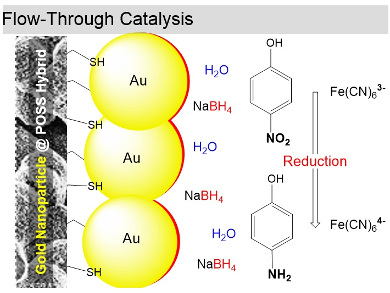Colloidal gold nanoparticles have excellent catalytic properties and are commercially available in a variety of shapes and sizes. Attaching them onto a suitable support prevents the particles from agglomerating and makes it easy to remove them from the reaction solution, facilitating reusability. However, finding robust supports for specific applications is still a challenge.
Ivo Nischang and colleagues, Friedrich Schiller University Jena, Germany, with collaborators in Linz, Austria, prepared hybrid organic–inorganic multiporous monolithic polyhedral oligomeric silsesquioxane (POSS) capillary columns functionalized to anchor gold nanoparticles of various sizes on their inner surface (see picture). This flow-through catalytic platform was tested for aqueous liquid-phase reduction reactions.
The system demonstrated excellent catalytic activity and reusability in the reduction of p-nitrophenol and hexacyanoferrate(III). Gold particles of 10 nm size led to the best overall performance. The results indicate that both the porous structure of the scaffold and the size of the gold nanoparticles affect the overall catalytic performance.
- Gold Nanoparticle@Polyhedral Oligomeric Silsesquioxane Hybrid Scaffolds in Microfluidic Format – Highly Efficient and Green Catalytic Platforms,
Pascal Scholder, Martina Hafner, Achim W. Hassel, Ivo Nischang,
Eur. J. Inorg. Chem. 2016.
DOI: 10.1002/ejic.201501376



